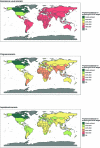Modeling global 80-80-80 blood pressure targets and cardiovascular outcomes
- PMID: 35851877
- PMCID: PMC9388375
- DOI: 10.1038/s41591-022-01890-4
Modeling global 80-80-80 blood pressure targets and cardiovascular outcomes
Abstract
As the leading cause of death worldwide, cardiovascular diseases (CVDs) present major challenges for health systems. In this study, we analyzed the effects of better population blood pressure control in the context of a proposed 80-80-80 target: 80% of individuals with hypertension are screened and aware of their diagnosis; 80% of those who are aware are prescribed treatment; and 80% of those on treatment have achieved guideline-specified blood pressure targets. We developed a population CVD model using country-level evidence on CVD rates, blood pressure levels and hypertension intervention coverage. Under realistic implementation conditions, most countries could achieve 80-80-80 targets by 2040, reducing all-cause mortality by 4-7% (76-130 million deaths averted over 2022-2050) and slowing the rise in CVD expected from population growth and aging (110-200 million cases averted). Although populous middle-income countries would account for most of the reduced CVD cases and deaths, low-income countries would experience the largest reductions in disease rates.
© 2022. The Author(s).
Conflict of interest statement
The authors declare no competing interests.
Figures






Similar articles
-
Scaling hypertension treatment in 24 low-income and middle-income countries: economic evaluation of treatment decisions at three blood pressure cut-points.BMJ Open. 2024 Apr 15;14(4):e071036. doi: 10.1136/bmjopen-2022-071036. BMJ Open. 2024. PMID: 38626959 Free PMC article.
-
Small-area variation of cardiovascular diseases and select risk factors and their association to household and area poverty in South Africa: Capturing emerging trends in South Africa to better target local level interventions.PLoS One. 2020 Apr 22;15(4):e0230564. doi: 10.1371/journal.pone.0230564. eCollection 2020. PLoS One. 2020. PMID: 32320425 Free PMC article.
-
Temporal trend and attributable risk factors of cardiovascular disease burden for adults 55 years and older in 204 countries/territories from 1990 to 2021: an analysis for the Global Burden of Disease Study 2021.Eur J Prev Cardiol. 2025 May 12;32(7):539-552. doi: 10.1093/eurjpc/zwae384. Eur J Prev Cardiol. 2025. PMID: 39591503
-
Global Burden of Cardiovascular Diseases and Risk Factors, 1990-2019: Update From the GBD 2019 Study.J Am Coll Cardiol. 2020 Dec 22;76(25):2982-3021. doi: 10.1016/j.jacc.2020.11.010. J Am Coll Cardiol. 2020. PMID: 33309175 Free PMC article. Review.
-
The epidemiology of blood pressure and its worldwide management.Circ Res. 2015 Mar 13;116(6):925-36. doi: 10.1161/CIRCRESAHA.116.304723. Circ Res. 2015. PMID: 25767281 Review.
Cited by
-
Association of mercury exposure with the serum high-sensitivity C-reactive protein level in Korean adults.Front Public Health. 2023 Mar 28;11:1062741. doi: 10.3389/fpubh.2023.1062741. eCollection 2023. Front Public Health. 2023. PMID: 37056650 Free PMC article.
-
Cardiovascular diseases in Africa in the twenty-first century: Gaps and priorities going forward.Front Cardiovasc Med. 2022 Nov 10;9:1008335. doi: 10.3389/fcvm.2022.1008335. eCollection 2022. Front Cardiovasc Med. 2022. PMID: 36440012 Free PMC article. Review.
-
Integrative and complementary practices in health, nurses' profile and care provided to people with hypertension: a mixed study design.Rev Lat Am Enfermagem. 2023 May 15;31:e3914. doi: 10.1590/1518-8345.6287.3914. eCollection 2023. Rev Lat Am Enfermagem. 2023. PMID: 37194812 Free PMC article.
-
HEARTS en las Américas: salvar vidas de la enfermedad más letal del mundo.Rev Panam Salud Publica. 2022 May 10;46:e189. doi: 10.26633/RPSP.2022.189. eCollection 2022. Rev Panam Salud Publica. 2022. PMID: 36211248 Free PMC article. Spanish. No abstract available.
-
Understanding Gaps in the Hypertension and Diabetes Care Cascade: Systematic Scoping Review.JMIR Public Health Surveill. 2024 Feb 16;10:e51802. doi: 10.2196/51802. JMIR Public Health Surveill. 2024. PMID: 38149840 Free PMC article.
References
Publication types
MeSH terms
Grants and funding
LinkOut - more resources
Full Text Sources
Medical
Research Materials

